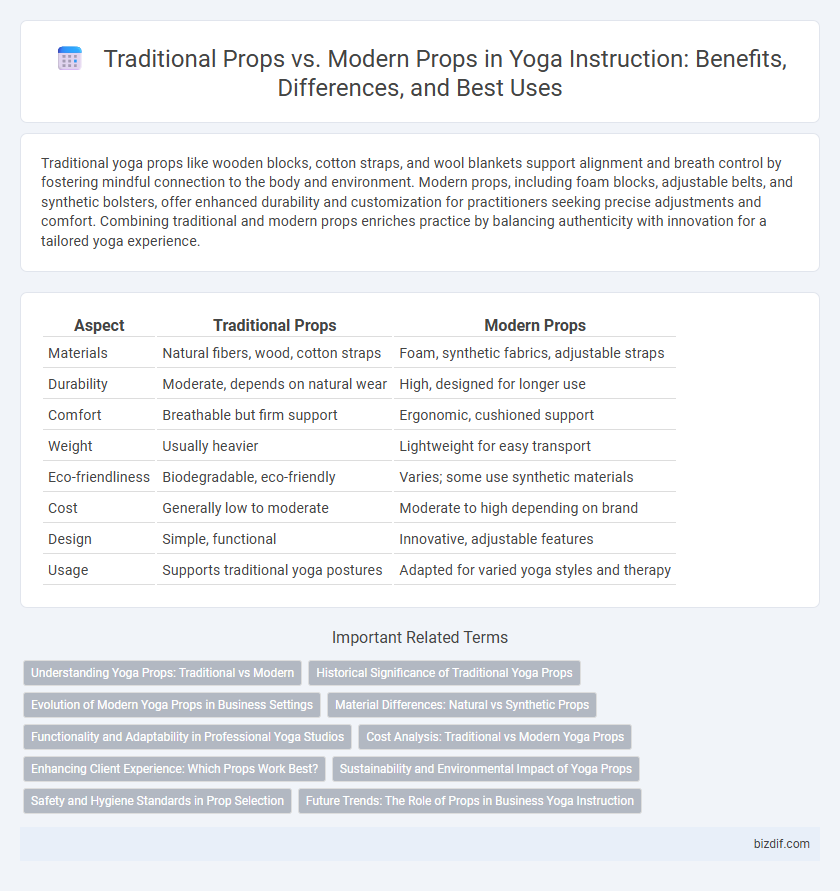Traditional yoga props like wooden blocks, cotton straps, and wool blankets support alignment and breath control by fostering mindful connection to the body and environment. Modern props, including foam blocks, adjustable belts, and synthetic bolsters, offer enhanced durability and customization for practitioners seeking precise adjustments and comfort. Combining traditional and modern props enriches practice by balancing authenticity with innovation for a tailored yoga experience.
Table of Comparison
| Aspect | Traditional Props | Modern Props |
|---|---|---|
| Materials | Natural fibers, wood, cotton straps | Foam, synthetic fabrics, adjustable straps |
| Durability | Moderate, depends on natural wear | High, designed for longer use |
| Comfort | Breathable but firm support | Ergonomic, cushioned support |
| Weight | Usually heavier | Lightweight for easy transport |
| Eco-friendliness | Biodegradable, eco-friendly | Varies; some use synthetic materials |
| Cost | Generally low to moderate | Moderate to high depending on brand |
| Design | Simple, functional | Innovative, adjustable features |
| Usage | Supports traditional yoga postures | Adapted for varied yoga styles and therapy |
Understanding Yoga Props: Traditional vs Modern
Traditional yoga props such as wooden blocks, cotton straps, and bolsters crafted from natural materials emphasize grounding and authenticity in practice, often reflecting the ancient origins of yoga. Modern props, including lightweight foam blocks, adjustable straps with buckles, and inflatable bolsters, offer enhanced portability, durability, and customization to accommodate diverse body types and flexibility levels. Understanding the differences between traditional and modern props helps practitioners select tools that best support alignment, stability, and comfort during yoga sessions.
Historical Significance of Traditional Yoga Props
Traditional yoga props such as wooden blocks, cotton straps, and natural fiber mats carry historical significance rooted in ancient Indian practices, fostering authentic alignment and mindfulness. These materials were chosen for their natural origins and durability, supporting long-term practice and spiritual connection. Unlike modern synthetic props, traditional tools emphasize sustainability and a deep respect for yoga's cultural heritage.
Evolution of Modern Yoga Props in Business Settings
Traditional yoga props such as wooden blocks, cotton straps, and wool blankets provided foundational support for alignment and comfort. Modern yoga props have evolved to include eco-friendly materials like cork blocks, adjustable straps with durable buckles, and non-slip mats designed for high-traffic business environments. These advancements enhance user experience, durability, and hygiene, making them ideal for corporate wellness programs and studio settings focused on scalable and sustainable yoga practice.
Material Differences: Natural vs Synthetic Props
Traditional yoga props are typically crafted from natural materials such as wood, cotton, and jute, offering eco-friendly, biodegradable qualities that enhance grip and breathability. Modern yoga props often use synthetic materials like PVC, foam, and polyester, delivering durability, lightweight portability, and moisture resistance suitable for diverse practice conditions. The choice between natural and synthetic materials impacts environmental sustainability, user comfort, and the tactile experience during poses.
Functionality and Adaptability in Professional Yoga Studios
Traditional yoga props such as wooden blocks, cotton straps, and wool blankets provide firm support and align with the philosophy of natural materials, enhancing sensory connection during practice. Modern props, including foam blocks, adjustable straps, and eco-friendly mats, offer greater versatility and customization, allowing instructors to tailor sessions to diverse student needs and body types. Professional yoga studios benefit from incorporating both types to optimize functionality and adaptability, ensuring safety and enhancing overall practice quality.
Cost Analysis: Traditional vs Modern Yoga Props
Traditional yoga props such as wooden blocks, cotton straps, and wool blankets typically incur lower upfront costs due to their natural materials and simpler manufacturing processes. Modern yoga props, including foam blocks, synthetic straps, and memory foam cushions, often have higher prices reflecting advanced materials and ergonomic designs aimed at enhancing comfort and durability. A cost analysis reveals traditional props offer budget-friendly options with basic functionality, while modern props demand higher investment but provide improved performance and longevity for dedicated practitioners.
Enhancing Client Experience: Which Props Work Best?
Traditional yoga props such as wooden blocks, cotton straps, and wool blankets offer authentic sensory feedback and promote alignment awareness during practice. Modern props, including foam blocks, elastic bands, and memory foam bolsters, provide enhanced comfort, durability, and ergonomic support tailored to diverse client needs. Choosing between traditional and modern props depends on balancing authenticity with client-specific requirements for improving stability, flexibility, and overall experience.
Sustainability and Environmental Impact of Yoga Props
Traditional yoga props, often made from natural materials like wood, cotton, and jute, offer significant sustainability benefits due to their biodegradability and renewable sourcing. In contrast, many modern props utilize synthetic materials such as PVC and foam, which contribute to environmental pollution and longer decomposition times. Choosing eco-friendly yoga props reduces the carbon footprint and supports sustainable yoga practice by minimizing waste and promoting the use of recyclable or biodegradable materials.
Safety and Hygiene Standards in Prop Selection
Traditional yoga props, such as wooden blocks and cotton straps, often lack standardized safety certifications and can harbor bacteria due to porous materials and difficulty in thorough cleaning. Modern props made from high-density EVA foam and medical-grade silicone prioritize non-toxic, antimicrobial properties and are designed for easy sanitation, enhancing hygiene during practice. Selecting props that meet current safety and hygiene standards minimizes the risk of injury and infection, promoting a safer and more hygienic yoga environment.
Future Trends: The Role of Props in Business Yoga Instruction
Traditional yoga props like blocks, straps, and bolsters provide tactile support and alignment aid, foundational for precise postures and injury prevention. Modern yoga props incorporate advanced materials and adjustable features, enhancing customization and comfort tailored to individual practitioners' needs. Future trends indicate growing integration of smart props equipped with sensors and digital feedback, transforming business yoga instruction into a technology-driven, personalized wellness experience that boosts client engagement and retention.
Traditional props vs Modern props Infographic

 bizdif.com
bizdif.com